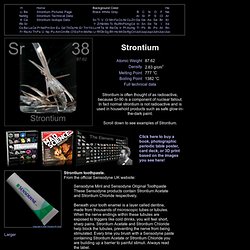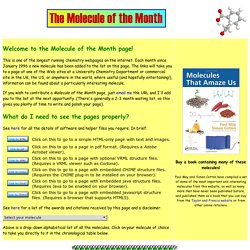

Pictures, stories, and facts about the element Strontium in the Periodic Table. Real strontium.

Strontium metal is hard to get. In fact, it was in the very last group of elements I was able to acquire to complete my collection. It was donated by the extremely kind Max Whitby of the The Red Green & Blue Company, which sells a complete collection of elements. They sell a very nice element collection in several versions. Max Whitby, the director of the company, very kindly donated a complete set to the periodic table table. To learn more about the set you can visit my page about element collecting for a general description or the company's website which includes many photographs and pricing details. The picture on the left was taken by me. Source: Max Whitby of RGBContributor: Max Whitby of RGBAcquired: 25 January, 2003Text Updated: 11 August, 2007Price: DonatedSize: 0.5"Purity: 99%
GoREACT. The world is your laboratory!

Experiment with chemistry virtually anywhere with goREACT! In this drag-and-drop laboratory, combine elements from the Periodic Table to create chemical reactions and discover the chemistry in the world around you! With goREACT, you can become a virtual chemist. Whether you're a novice or expert, the free play and guided modes make it fun and fascinating. Initiate nearly 300 virtual chemical reactions by dragging elements into the Reaction Area.Amazing images and videos illustrate the molecules you create.Select alternate views of the Periodic Table to discover different aspects of the elements’ chemical properties.Touch any of the Periodic Table's 118 elements to see an image and fun fact about it.With helpful hints about reactions to try, there’s always something exciting to explore. Play Online » The Chemistry of Fireworks. Click to enlarge The colours in fireworks stem from a wide variety of metal compounds – particularly metal salts.

‘Salt’ as a word conjures up images of the normal table salt you probably use every day; whilst this is one type of salt (sodium chloride), in chemistry ‘salt’ refers to any compound that contains metal and non-metal atoms ionically bonded together. So, how do these compounds give the huge range of colours, and what else is needed to produce fireworks? The most important component of a firework is, of course, the gunpowder, or ‘black powder’ as it is also known. It was discovered by chance by Chinese alchemists, who were in actuality more concerned with discovering the elixir of life than blowing things up; they found that a combination of honey, sulfur and saltpetre (potassium nitrate) would suddenly erupt into flame upon heating. Caffeinated-biologist: Spark, Spark! The...
Real Monstrosities on tumblr — c1ementine: m1ssred: chemical reaction ...
Chemistry resources for Teachers and Students. Earthquakes. 2. chemistry of the elements. Chemistry. Education Support3. Molecule of the Month. Welcome to the Molecule of the Month page!

This is one of the longest running chemistry webpages on the internet. Each month since January 1996 a new molecule has been added to the list on this page. The links will take you to a page at one of the Web sites at a University Chemistry Department or commercial site in the UK, the US, or anywhere in the world, where useful (and hopefully entertaining!) , information can be found about a particularly interesting molecule. If you wish to contribute a Molecule of the Month page, just email me the URL and I'll add you to the list at the next opportunity. What do I need to see the pages properly? See here for all the details of software and helper files you require. See here for a list of the awards and citations received by this page and a disclaimer. Above is a drop-down alphabetical list of all the molecules. Buy a book containing many of these molecules!